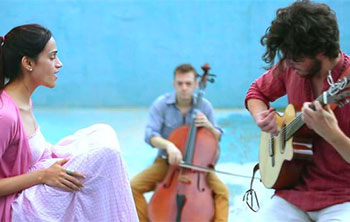 06th September, 2016
06th September, 2016In the late 1990s and early 2000s, when Indipop had fizzled out and DJ remixes of Bollywood classics ruled the charts, a revolution was brewing on the sidelines. In garages, pubs and shady clubs across the country, a new generation of musicians was emerging – one which chose artistic freedom over commercial viability.
Bands like Parikrama, Indus Creed, Indian Ocean, Zero and Pentagram ignored market trends and warnings about the lack of money in ‘Western Music’ in order to create the kind of music they listened to and loved. In the process, they helped create the space for what we now call ‘Indie Music’. Though Western music such as rock, blues, and electronica had been around in India for a long time, it was in these years that indie music took its first steps towards mass popularity.
Millennials are a demanding lot, always looking for fresh and new sounds, which encouraged independent artists to innovate and produce music for the audience on their own terms. Ever since the first big surge of indie artists in the 1990s, the trend of creating music independently, away from commercial labels has been on an upswing.
Originally, indie was an umbrella term conjured up to include any music that was produced independently. Now, we are moving away from that ambiguous definition to a more structured space. Indie music now has various sub-genres including indie rock, indie pop, and even indie electronica, all characterised by a willingness to experiment and create music that pushes the envelope. Mainstream music like Bollywood, pop and EDM still draws a huge crowd, but now Indie Music is not far behind.
From lowly paid (or often unpaid) club gigs and college competitions, we have come a long way to 3-day music festivals that only feature Indie Music. In fact, Indie artists like Prateek Kuhad, Nicholson and Vasudha Sharma grace the stage at many music festivals, adding to their loyal following with every performance. Though nobody in the 1990s expected it, Indie Music is now popular enough to have an entire channel dedicated to it, which enjoys great viewership among the target audience. However, the Indie Music industry is still in its early years, and the road to indie stardom is fraught with struggle.
Since Indie Music is still considered a work-in-progress, trailing behind Bollywood and EDM when it comes to audience numbers, there are many challenges faced by artists working in the indie space. The lack of adequate remuneration and resources – even today – has forced many an independent musician to trade in creative satisfaction for the economic security that comes with a career in Bollywood or the advertising industry.
Infrastructure is yet another issue, as music companies are still hesitant about investing in talent unless they are sure of returns, and marketing campaigns are restricted due to restraint of budget. The lack of good venues and an established touring circuit also prevents many bands from reaching their full potential. A flip side to working independently, that we have seen, is the ever-present threat of being side-lined by artists signed to major labels and studios with massive marketing budgets. Making a mark in an already established field is a big challenge for the new artists who generally start out in their bedrooms or garages.
However, despite swimming with sharks, independent musicians continue to enjoy their freedom and growth. Not working under anyone lets the artists explore and experiment with compositions that are unique and which gives them flexibility, independence, and control to choose and perform their own music at their own pace. This quality has indeed struck a chord amongst the audience, and as more and more artists deviate from the mainstream labels, going independent has become the choice du jour.
There is also a new breed of young entrepreneurs – label heads, artist managers, and event promoters - that is hard at work building the infrastructure and economy needed to support and encourage upcoming artists through their journey to success. Thanks to technology, digital platforms, crowd sourcing, the barrier between artist and audience no longer exists, building a relationship that goes beyond just the transactions of sale and purchase
The fresh, original, and experimental nature of Indie Music was a contributing factor towards the scene’s initial boost in popularity. As more and more artists experiment with independent labels, a new wave in the music industry is on the rise. Various platforms and opportunities have been a contributing factor to this transformative phase in the industry. What we are seeing now is just the tip of the iceberg.
Thanks to globalisation (and the internet), we have now been extensively exposed to global music – indie or commercial -with most of us capable of waxing eloquent about our new favourite on the scene. It’s time our artists also enjoy the same popularity on foreign shores. While bands like Orange Street, Parikrama and Indian Ocean have enthralled audiences at global stages, these tours have been sporadic and uns unstained. What we need is to build an ecosystem that encourages and supports local acts with the potential to be the next Arctic Monkeys or Alt J, enjoying the same popularity as any commercial band or artist globally. We need to show the world that Indie Music is as native to India as is Bollywood; that Raghu Dixit and Swarathma belong on the dance floor just as much as the latest Bollywood hit.
The rise of Indie Music in this country seems unstoppable. We just need to make sure we don’t repeat the same mistakes that killed the Indipop music culture of the 1990s in India. We need to learn from our past and stand united as an industry that supports talent both established and upcoming.
Suman Singh, CEO, Bajaao.com
